«Swiss Grand Canyon».
Rhine Gorge Experience
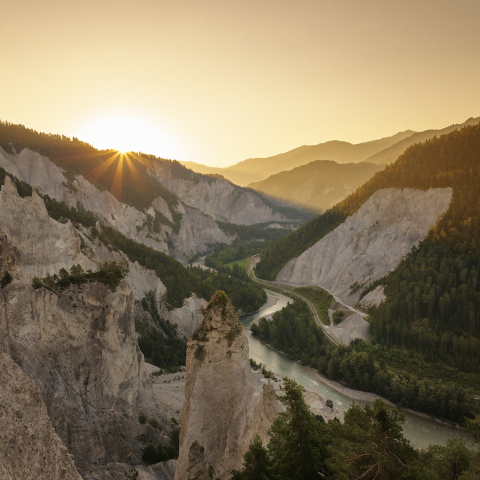
Formation of the Rhine Gorge
The 14-kilometre Rhine Gorge – “Ruinaulta” in Rhaeto-Romanic – between Ilanz and Reichenau was created 9,500 years ago by the enormous Flims rockslide. Between 9 and 12 cubic kilometres of rock rumbled down at the time and buried the Anterior Rhine under a mass of debris several hundred metres thick. A 25-kilometre-long lake was dammed. However, over time, the river cut deep into the debris mass. The Ilanz lake flowed away – and the Rhine Gorge was formed.
Reichenau
Where the Anterior Rhine and Posterior Rhine come together, guarded by castle walls, is the eastern gate to the gorge. Those heading to Ruinaulta go past here – and could perhaps also encounter Francesca from Tscharner. Growing up in Reichenau as the daughter of the castle owner has shaped the young woman; «a dream», she says. «Here is my home.» However, she is also a real nature lover and replenishes her energy in nature. And so she is often drawn to the region around Ruinaulta.
In the castle where she once went on endless treasure hunts with her siblings, she takes care of events and marketing; the complex with the park is very popular among wedding couples. Brother Johann-Baptista runs the castle’s own winegrowing company, sister Marina takes care of the supporter society «Friends of Reichenau». The historic building is both an honour and a burden. «Its future is by no means secure,» says Francesca. But the whole family is working on it. Francesca also gains energy for this in the gorge. «My husband and I have even already considered doing a course to travel along the Rhine by canoe.»
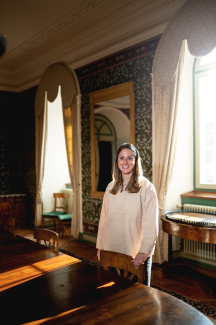
Versam
WasserchRAFT, Swiss River Adventures, Versam canoe school: those who want to experience the Anterior Rhine on a rafting tour will have no trouble finding experienced providers. It is logical for Kasi Fellmann that, alongside having fun, consideration for nature is also important. «The river is the basis of our lives, we care about protecting this environment,» says the head of the canoe school. «Without shutting people out.»
Regardless of whether they opt for a whitewater adventure or a more sedate option, those who paddle through the gorge in a canoe or dinghy will learn about the flora and fauna in the «natural wonder of the Flims rockslide», as Kasi calls Ruinaulta. «We talk about the meadow landscape and the rare birds that are native to this area. Our customers should know how to move correctly within the river landscape.» And the guides are naturally delighted when they can unexpectedly draw guests’ attention to one of the rare sandpipers. The canoe school travels by train to the start of a tour and the boats are pumped up by hand. «That,» emphasises Kasi, «also shows that protecting nature is not always convenient.»
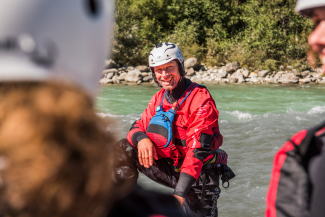
Trin
Protecting nature: in the Rhine Gorge, this is one of Hitsch Malär’s jobs. The retired forester is an official Ruinaulta ranger, and he «puts heart and soul» into the job, as he says. From his house in Trin, he only needs travel 500 metres before he can stand at the edge of the gorge and look down onto the meandering river. This is his stomping ground, he spends around three hours trekking through Ruinaulta when he does his job in his ranger’s outfit and with a tablet for important entries. «And with binoculars, we don’t have any other ‘weapons’,» he says with a grin.
«If I meet anyone when I’m out, I talk to them. As a ranger, you have to like talking to people.» The first of many questions that he then has to answer: What have we done? But the rangers should not be police officers. «We inform, give tips, guide the visitors.» In particular, gravel islands in the water must not be accessed during the breeding season of rare birds from April to July. For Hitsch, it’s clear: «Being a ranger is an extremely wonderful job. And you almost couldn’t imagine the gorge without us.»
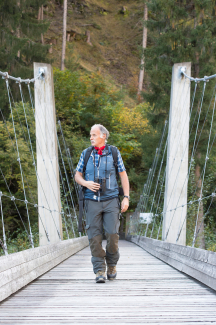
Valendas
No matter whether you are hiking or paddling: if you start feeling a bit peckish, you can have a barbecue, visit a station pub, or climb up to the villages on the edge of Ruinaulta. Like Trin, Versam – or Valendas. There, in the «Gasthaus am Brunnen», you will find the culinary kingdom of Matthias Althof and Elvira Solèr. «The gorge is simply part of the identity of Valendas,» says Elvira. And thus part of her life since her earliest childhood. Even today, she still loves going walking in the monument of nature.
The pastry chef and confectioner would never have thought that she would return to the village of her youth after the years she spent doing her apprenticeship and travelling. But then she and her husband were given the opportunity to take over the new guesthouse. They have been a permanent gastronomic fixture in the region ever since. They focus on products from the village: meat, eggs, vegetables – «the range is great, and the people are innovative,» raves Elvira. She feels very comfortable in Valendas, «everyone sticks together.» They just have not yet managed to bring the river onto the menu. «Fish from the Rhine, that would be lovely,» she muses. «If someone brought a sufficient quantity of them to us, we would definitely take them.»
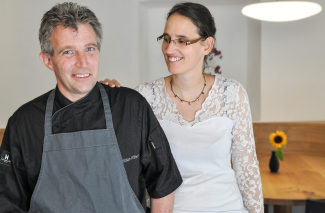
Did you know...?
The 14-kilometre Rhine Gorge – «Ruinaulta» in Rhaeto-Romanic – between Ilanz and Reichenau was created 9,500 years ago by the enormous Flims rockslide. Between 9 and 12 cubic kilometres of rock rumbled down at the time and buried the Anterior Rhine under a mass of debris several hundred metres thick. A 25-kilometre-long lake was dammed. However, over time, the river cut deep into the debris mass. The Ilanz lake flowed away – and the Rhine Gorge was formed.







